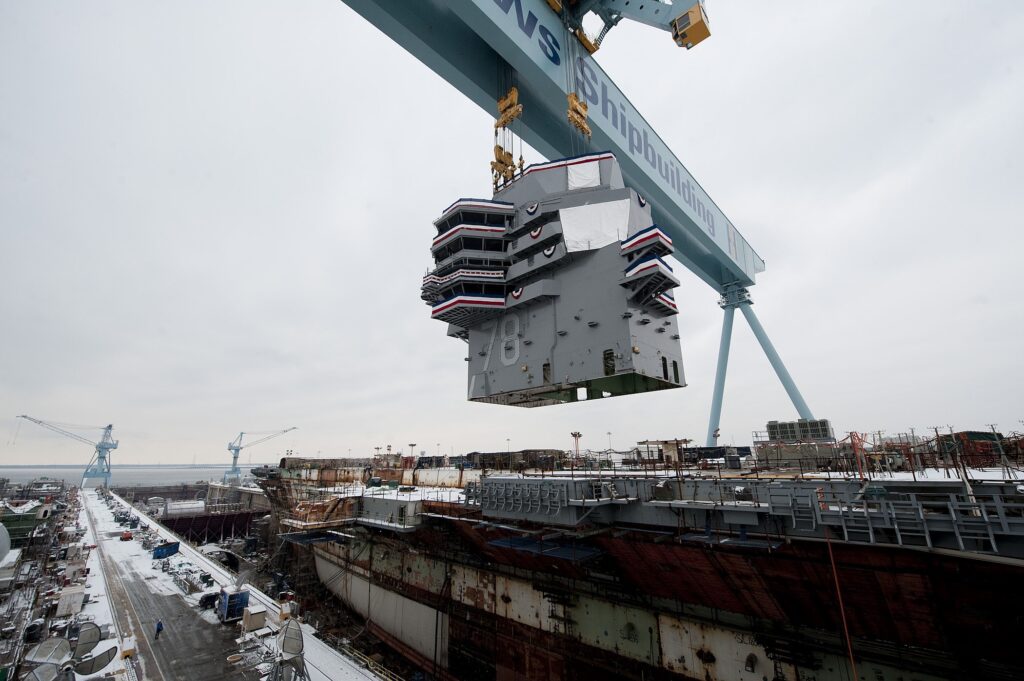
The nuclear carrier USS Ford (CVN-78) under construction at Newport News shipyard.
PENTAGON: The Navy has taken a big step toward pushing all of its data and analytics functions onto the cloud, setting the stage for the transition from disconnected and dispersed networks and databases into a single cloud-based system.
The move of 72,000 users spread across six Navy commands to an Amazon Web Services cloud system this week is the first move in a three-year, $100 million effort, Navy leaders announced today.
The milestone — which came 10 months ahead of schedule — will put the movement and documentation of some $70 billion worth of parts and goods into one accessible space, where the information can be shared, analyzed and protected in a more uniform fashion.
“Part of this larger transformation is to make all the data available to everybody in as near real-time [as possible], with a lot of resilience and a lot of reliability,” Navy acquisition chief James Geurts told reporters in his office at the Pentagon today. “It gives us a lot more flexibility going forward, whether its with JEDI or another cloud-based system we decide to ride on.”
The rest of the Navy’s acquisition, logistics, and back office data will be moved to the cloud over the next two years.
One of the biggest benefits to the Navy, Geurts said, is that sailors and civilians on the pier or on the flight line will be able to reach into the cloud to keep an eye on parts bouncing through the pipeline, giving them a better idea of what is moving where within the service’s massive maintenance and acquisition system.
Simply put, “it will increase the visibility of the data,” Navy Comptroller Thomas Harker added. “Right now, in order to run audits the Navy has to pull data from nine different systems, not all of which are configured the same, and then slice it and dice it and put it all together.” Working that way is time consuming, and “creates challenges in financial reporting. It also creates challenges in doing advanced analytics around that data,” he added.
Getting a handle on this kind of information and doing it quickly, is critically important for the Navy as it struggles with deep-seated maintenance and repair backlogs that have kept ships pier-side months longer than was initially planned, as parts go missing or get jammed up inside the massive logistics enterprise.
Recently, Navy undersecretary Thomas Modly admitted that the Navy has done a poor job in spending money to protect its networks. Part of the problem is that there has been no one person at a senior level responsible for making sure the multiple networks were secure. “It was very distributed, so we found we were investing in things without any level of coordination,” Modly said in announcing a new senior advisor the the Navy Secretary to run the cyber security portfolio.
The Navy effort is part of a wider push at the Pentagon to get information away from multiple networks onto a single cloud-based system.
The military absolutely needs to stand up the JEDI cloud computing program in order to stay abreast of China and Russia, the three-star chief of the Pentagon’s Joint Artificial Intelligence Center said recently. If the Pentagon fails to build a common system to share data rapidly among units in different services and different globally-dispersed theaters, it’ll fail to implement the kinds of high-speed, AI-assisted Multi-Domain Operations that military leaders say are imperative in potential future conflicts against advanced adversaries.
Shipbuilder Austal USA names Michelle Kruger as new president
Kruger had been serving as interim president since former chief Rusty Murdaugh resigned last spring.



























